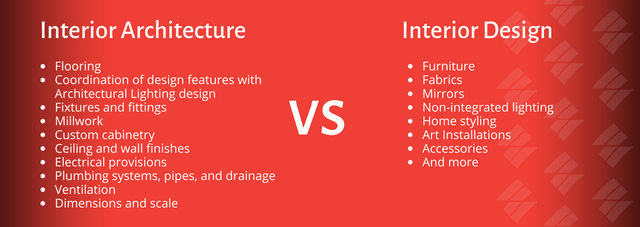Premier Winchester Design Expert for Unique Home Designs
Premier Winchester Design Expert for Unique Home Designs
Blog Article
The Art of Equilibrium: Just How Interior Design and Home Designer Collaborate for Stunning Outcomes
In the world of home style, striking a balance between aesthetic appeals and capability is no little feat. This delicate stability is accomplished via the unified collaboration in between indoor developers and architects, each bringing their one-of-a-kind expertise to the table. Keep with us as we discover the ins and outs of this collective process and its transformative impact on home layout.
Recognizing the Core Distinctions Between Inside Style and Home Architecture
While both Interior Design and home style play important roles in creating cosmetically pleasing and useful rooms, they are inherently various disciplines. Home style mostly focuses on the architectural facets of the home, such as developing codes, safety laws, and the physical construction of the space. It handles the 'bones' of the structure, dealing with spatial dimensions, bearing walls, and roof covering layouts. On the other hand, Interior Design is much more concerned with enhancing the sensory and visual experience within that structure. It involves selecting and setting up furnishings, selecting color plans, and integrating attractive components. While they work in tandem, their functions, duties, and locations of experience split significantly in the development of an unified home setting.
The Synergy Between Home Style and Interior Decoration
The harmony in between home design and Interior Design depends on a shared vision of layout and the improvement of useful aesthetics. When these two fields align harmoniously, they can change a space from regular to remarkable. This partnership requires a much deeper understanding of each technique's concepts and the capability to produce a natural, visually pleasing atmosphere.
Unifying Style Vision
Combining the vision for home design and indoor style can create a harmonious living space that is both practical and visually pleasing. It advertises a synergistic approach where architectural elements enhance indoor design components and vice versa. Thus, unifying the design vision is critical in mixing style and indoor design for magnificent results.
Enhancing Functional Looks
Exactly how does the harmony in between home architecture and Interior Design boost practical visual appeals? This synergy allows the production of rooms that are not only visually enticing but additionally conveniently usable. Engineers lay the groundwork with their architectural layout, making certain that the space is reliable and sensible. The interior developer after that complements this with very carefully selected components that improve the aesthetics without jeopardizing the performance. This harmonious collaboration can cause homes that are both stunning and liveable. An engineer may create a residence with big windows and high ceilings. The indoor developer can then emphasize these functions with sheer drapes and tall plants, respectively, thus boosting the visual appeal while preserving the functional advantages of natural light and space.
Relevance of Collaboration in Creating Balanced Spaces
The cooperation in between indoor designers and architects is essential in developing balanced spaces. It brings consistency in between design and architecture, bring to life areas that are not just visually pleasing yet also practical. Discovering successful collective methods can offer insights right into how this harmony can be properly attained.
Integrating Layout and Style
Equilibrium, a necessary element of both interior layout and design, can just really be accomplished when these 2 fields job in harmony. This collective process results in a cohesive, balanced design where every aspect has an objective and adds to the overall aesthetic. Balancing layout and architecture is not simply about developing stunning rooms, however about crafting areas that function flawlessly for their citizens.
Successful Collective Methods

Case Studies: Effective Integration of Layout and Architecture
Examining numerous case studies, it ends up being noticeable how the successful combination of interior layout and style can transform an area. Architect Philip Johnson and indoor developer Mies van der Rohe collaborated to produce an unified balance in between the framework and the inside, click here for info resulting in a seamless circulation from the outside landscape to the internal living quarters. These situation studies highlight the profound influence of a successful style and design cooperation.

Getting Over Challenges in Layout and Architecture Collaboration
Regardless of Read More Here the indisputable advantages of an effective collaboration in between indoor style and style, it is not without its obstacles. Designers may prioritize architectural stability and safety and security, while designers focus on convenience and style. Reliable communication, common understanding, and compromise are important to overcome these obstacles and attain a unified and effective partnership.

Future Patterns: The Progressing Connection In Between Home Architects and Interior Designers
As the world of home style continues to evolve, so does the connection in between designers and indoor designers. Alternatively, indoor designers are embracing technical facets, influencing overall design and performance. The future assures a more cohesive, innovative, and adaptive technique to home style, as designers and architects proceed to blur the lines, promoting a partnership that truly embodies the art of equilibrium.
Conclusion
The art of equilibrium in home design is achieved via the harmonious partnership between interior developers and engineers. Despite difficulties, this collaboration promotes development and advancement in design.
While both interior style and home architecture play vital duties in developing visually pleasing and useful rooms, they are inherently various techniques.The synergy in between home architecture and interior style exists in a shared vision of design and the enhancement of practical aesthetic appeals.Linking the vision for home design and indoor design can create a harmonious living area that is both practical and visually pleasing. Therefore, unifying the design vision is important in blending design and indoor style for sensational outcomes.
How does click here for info the harmony in between home style and indoor layout boost useful aesthetics? (Winchester architect)
Report this page